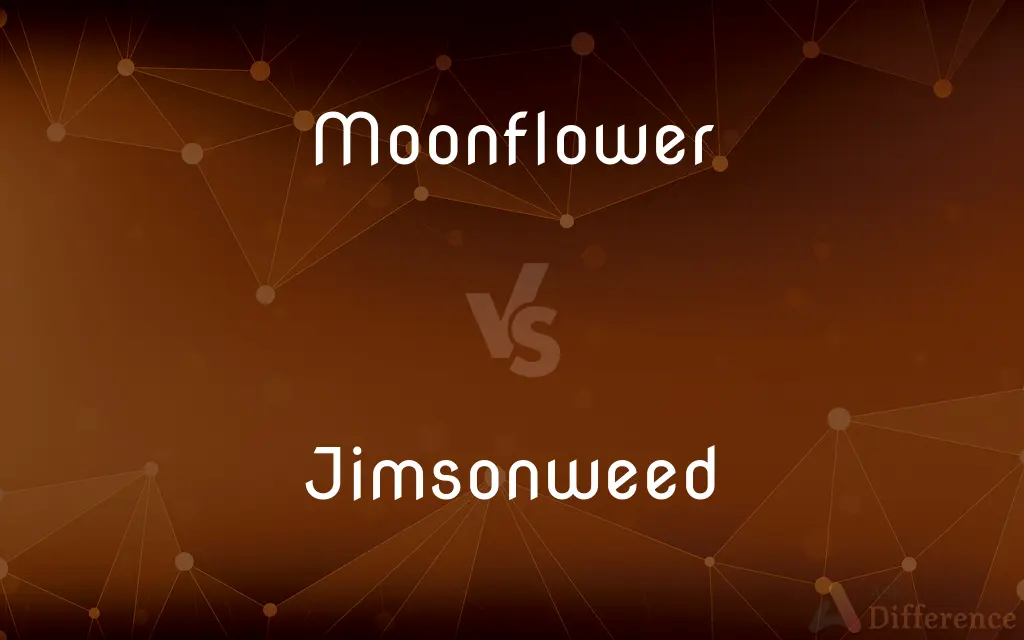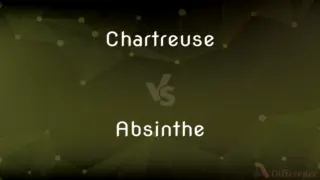Moonflower vs. Jimsonweed — What's the Difference?
Edited by Tayyaba Rehman — By Urooj Arif — Updated on April 23, 2024
Moonflower, white blooms that open at night, is often used in gardens for its aesthetic appeal, whereas Jimsonweed, recognized for its trumpet-shaped flowers and robust odor, is notorious for its toxicity and hallucinogenic properties.

Difference Between Moonflower and Jimsonweed
Table of Contents
ADVERTISEMENT
Key Differences
Moonflower, a species in the Ipomoea genus, features blooms that open in the evening and close by morning, adding a unique charm to nighttime gardens. On the other hand, Jimsonweed, which belongs to the Datura genus, also blooms in the evening but its flowers and leaves contain toxic alkaloids.
Moonflower vines are cultivated for their visual beauty and are often seen climbing on trellises and fences. Whereas, Jimsonweed is typically considered a weed and is often found growing in wild, untended areas.
Moonflower's fragrance is sweet and is considered appealing, attracting night pollinators like moths. In contrast, Jimsonweed has a pungent odor that can be unpleasant and is also pollinated by moths.
Despite the allure of moonflowers, they must be handled with care as they can be toxic if ingested. Jimsonweed, significantly more dangerous, poses a higher risk of poisoning to humans and animals alike.
In gardening, moonflower is appreciated for its rapid growth and large, heart-shaped leaves, providing lush foliage and privacy. Jimsonweed, though sometimes used for its dramatic appearance, is mostly avoided in cultivated gardens due to its invasive nature and the health risks it poses.
ADVERTISEMENT
Comparison Chart
Genus
Ipomoea
Datura
Flower Opening
Opens at night, closes by morning.
Opens at night, may stay open slightly longer.
Use in Gardens
Cultivated for aesthetic appeal in gardens.
Often removed from gardens due to toxicity.
Odor
Fragrant and sweet.
Strong and pungent.
Toxicity
Toxic if ingested, but generally less harmful.
Highly toxic, containing hallucinogenic alkaloids.
Pollination
Attracts night pollinators like moths.
Also pollinated by moths, but less desirable.
Compare with Definitions
Moonflower
Opens flowers at night, attracting pollinators.
The garden comes alive at night when the moonflowers open.
Jimsonweed
A weed with trumpet-shaped, toxic flowers.
The field was overrun with Jimsonweed, its white blooms noticeable at twilight.
Moonflower
Cultivated for decorative purposes.
We planted moonflower along the fence for its dramatic nighttime display.
Jimsonweed
Contains hallucinogenic properties.
Jimsonweed is often avoided due to its toxic and psychoactive effects.
Moonflower
Features heart-shaped leaves.
The moonflower’s heart-shaped leaves added to the lush appearance of the garden.
Jimsonweed
Grows in wild, untended areas.
We cleared the lot of Jimsonweed to prevent any accidental poisoning.
Moonflower
Can be toxic if ingested.
Keep children away from the moonflower pods, as they can be poisonous.
Jimsonweed
Emits a pungent odor.
The strong smell of Jimsonweed filled the air as we walked by the abandoned farm.
Moonflower
A vine with large, white, nocturnal flowers.
The moonflower vines covered the entire pergola, blooming beautifully at dusk.
Jimsonweed
Dangerous to humans and animals.
Ranchers remove Jimsonweed from pastures to protect livestock.
Moonflower
Any of several vines of the genus Ipomoea having trumpet-shaped flowers that open at night.
Jimsonweed
A poisonous annual plant (Datura stramonium) in the nightshade family, having large, trumpet-shaped white or purplish flowers and prickly egg-shaped seed capsules.
Moonflower
Any of several plants that flower at night:
Jimsonweed
(US) A poisonous plant of the Datura stramonium species, part of the nightshade (Solanaceae) family. A hallucinogen occasionally ingested by those looking for a cheap high.
Moonflower
(obsolete) The ox-eye daisy, Leucanthemum vulgare
Jimsonweed
Any poisonous plant of the genus Datura.
Moonflower
The corn marigold, Glebionis segetum.
Jimsonweed
Intensely poisonous tall coarse annual tropical weed having rank-smelling foliage, large white or violet trumpet-shaped flowers and prickly fruits
Moonflower
Any of several vines of the genus Ipomoea, especially Ipomoea alba.
Moonflower
Species in genus Cereus and in Hylocereus.
Moonflower
Species of Datura, including Datura inoxia.
Moonflower
Species of Mentzelia, including Mentzelia pumila.
Moonflower
The oxeye daisy; - called also moon daisy.
Moonflower
Pantropical climber having white fragrant nocturnal flowers
Common Curiosities
What is the best time to see moonflower blooms?
Moonflower blooms are best viewed at night as they open after dusk and close by morning.
Is moonflower safe to grow around pets?
While moonflower is less toxic than Jimsonweed, it is still advisable to keep pets away as it can be harmful if ingested.
How can Jimsonweed be identified?
Jimsonweed can be identified by its large, trumpet-shaped flowers, robust stem, and spiny seed pods.
Can Jimsonweed be used for any beneficial purposes?
Despite its toxicity, Jimsonweed has been used historically in traditional medicine, though it is not recommended without professional guidance.
What are the risks associated with Jimsonweed?
Jimsonweed poses significant risks including poisoning and hallucinations, due to its alkaloid content.
What do moonflower seeds look like?
Moonflower seeds are hard, black, and about the size of a small pea.
What climates are suitable for growing moonflower?
Moonflower thrives in warm, temperate to tropical climates but can be grown in cooler areas with summer planting.
How long do Jimsonweed plants live?
Jimsonweed is an annual plant, completing its life cycle within one year.
How fast do moonflower vines grow?
Moonflower vines can grow quite rapidly, often able to cover a trellis or fence within a single growing season.
How do moonflowers benefit a night garden?
Moonflowers add beauty and fragrance to night gardens, attracting nocturnal wildlife like moths.
Why is Jimsonweed considered invasive?
Jimsonweed is considered invasive due to its rapid growth and ability to spread quickly, often dominating areas where it grows.
Can Jimsonweed be removed safely?
Removing Jimsonweed requires care to avoid contact with its toxic parts and should ideally be done wearing gloves.
Can moonflower be used in indoor gardening?
Moonflower can be grown indoors if provided with sufficient climbing space and exposure to light, though it thrives outdoors.
Are Jimsonweed flowers always white?
Jimsonweed flowers are usually white, but some species may have a purple or yellow hue.
What are some safety precautions for planting moonflower in a home garden?
It’s important to ensure that moonflower is planted away from children and pets, and to handle with gloves to avoid skin irritation.
Share Your Discovery

Previous Comparison
Chartreuse vs. Absinthe
Next Comparison
Forge vs. FurnaceAuthor Spotlight
Written by
Urooj ArifUrooj is a skilled content writer at Ask Difference, known for her exceptional ability to simplify complex topics into engaging and informative content. With a passion for research and a flair for clear, concise writing, she consistently delivers articles that resonate with our diverse audience.
Edited by
Tayyaba RehmanTayyaba Rehman is a distinguished writer, currently serving as a primary contributor to askdifference.com. As a researcher in semantics and etymology, Tayyaba's passion for the complexity of languages and their distinctions has found a perfect home on the platform. Tayyaba delves into the intricacies of language, distinguishing between commonly confused words and phrases, thereby providing clarity for readers worldwide.













































